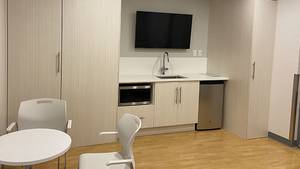This year the QEII Health Sciences Centre celebrates 20 years of changing and saving lives. These past two decades haven’t been marked by calendar days or months, but by moments experienced every day by QEII patients and their loved ones.
The QEII has a rich history dating back to 1859 when the Halifax City Hospital was established at the current VG site. The hospital continued to grow and change for more than a century. In 1996, the QEII was created through the merger of several major facilities, including the former Halifax Infirmary, the Abbie J. Lane Memorial Building, Victoria General Hospital, Nova Scotia Rehabilitation Centre, Cancer Treatment Research Foundation and Camp Hill Veterans Memorial Building.
Bill Hayward was at the centre of it all.
“Twenty years ago, I was appointed Chair of the QEII Board to help facilitate the merger,” says Bill. “It was a large undertaking, to organize one facility that would provide health care for thousands of patients from across the region.”
Bill worked closely with Neil Roberts, CEO of the then new QEII. With the opportunity to reduce costs and increase collaboration between QEII departments, as well as with Dalhousie Medical School, Bill and Neil had a vision for what the QEII could be.
“The QEII was established to provide specialized care to the region,” says Bill.
“And with hard work and contributions from many, we were able to achieve that,” adds Neil.
Today, the QEII is the largest adult health sciences centre in Atlantic Canada. While providing immediate and emergency care to the Halifax area, the QEII serves as the specialized care centre in areas such as heart health, cancer care, neurosurgery and organ transplantation. It is also a leading medical research and teaching centre for tomorrow’s healthcare professionals.
Throughout the past 20 years, care at the QEII has grown with time and technology. With the goal of maintaining and enhancing the standard of care, the QEII continues to provide the best care possible for Atlantic Canadians.
“It was important for the QEII to not only provide, but enhance, specialized care,” says Bill. “All of these services have advanced greatly over the last 20 years, making Halifax a major centre of excellence in health care.”
All of this would not have been possible without the QEII Foundation.
Along with the merger of the healthcare facilities into the QEII, Neil recognized the need for one unified health centre foundation.
“With a new collaborative health centre that would see patients from across Atlantic Canada, we needed a foundation to help advance health care for everyone,” says Neil. “With this in mind, I put the wheels in motion to create the QEII Foundation.”
With 20 years of continued financial support from all levels of the community, the QEII Foundation helps fund new technologies, medical research, innovation and professional education that contribute to life-changing moments experienced every day by patients and their loved ones at the QEII. To date, the QEII Foundation has raised more than $190-million to advance health care at the QEII.
“Twenty years ago the QEII Foundation began its commitment to supporting health care for Atlantic Canadians,” says Bill Bean, president and CEO of the QEII Foundation. “The Foundation community has helped advance health care through their contributions for leading-edge technology such as the 3T MRI, new facilities such as the Charles V. Keating Emergency and Trauma Centre, and research initiatives like QEII Foundation Endowed Research Chairs.”
The healthcare landscape continues to transition as the province undergoes a redevelopment of care at the QEII. The QEII Foundation is poised to be a part of this transformational change. Change that will see an expanded cancer care program, new space for specialized outpatient care, and relocated complex services as well as community services.
“Together, as we plan for how health care is delivered 50 years from now, we can help shape patient care for generations to come,” says Bill Bean. “It is an exciting time for health care in this province and we couldn't be more energized to be a part of it with our community of donors.”








